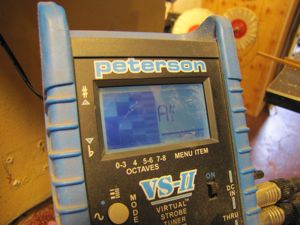What is a Setup? Quite simply, a Setup is the adjustment of an instrument to the preferences of the player. Almost every guitar has a wide array of things that can be adjusted to suit the player’s taste: action all over the fingerboard, neck relief, bridge height and radius, intonation, nut height, pickup height, etc. Every adjustment should be to the tightest of tolerances possible – often down to less than .001″.
Why do you need a professional Setup? Even if your instrument is brand new, straight out of the factory or off the showroom floor, no matter how expensive it is, chances are that it’s Setup is far from perfect. Let’s face it: guitar manufacturers are not in the business of handcrafting individual works of art – they are in the business of making as many guitars as they can in the shortest amount of time possible. It’s simply not in their best financial interests to make the perfect guitar – they’d go broke. Making your guitar perfect is our #1 priority at SF Guitarworks, and providing a perfect Setup is a huge part of what we do. We’ve invested countless hours improving our craft, and spent thousands of dollars on the most up to date tools and technology to guarantee accurate, consistent results. No matter your playing style, how long you’ve been playing, or what kind of guitar you play, your instrument will feel better, play more in tune, and yes, even sound better.
We take a very thorough, methodical approach to a Setup at SF Guitarworks. First of all, it’s important to understand that each part of the setup influences the others – we don’t just start making adjustments at random. We do everything in a particular order – we don’t skip steps, and no shortcuts are taken. When a guitar is brought in to our shop, we first assess the instrument and talk with the player about their individual needs. We don’t just set up a guitar to play the way we think it should play; we set it up to the way you play.
Here’s how we do it:

1. We begin by taking careful measurements on the guitar, and notate these on a Setup Checklist which we will give you with the completed guitar. We want you to know that you’re getting personalized, measurable results. These are the initial measurements we take –
Action: Measured in thousandths of an inch at the 12th fret while fretted at the 1st fret, on both the bass side and treble side.
Relief: The amount of space between the bottom of the lowest string and the top of the 6th fret while fretted at the 1st and 13th fret, measured in thousandths of an inch.
Bridge Radius: The arch of the strings at the bridge, measured with a radius gauge in inches.
String Gauge: The size of the strings, measured in thousandths of an inch.
2. We then remove the old strings, polish the frets, clean and oil the fingerboard.
3. We check and tighten all hardware, and oil the machine heads when necessary.

4. With the strings off, we measure the fretboard radius. What’s a radius? A radius is the measurement from the center point of a circle to it’s edge. A guitar’s fretboard is almost never flat – it’s curved. The curve of the board is essentially just a segment of a larger circle, usually with a radius of 7.25″-20″. We measure it at this stage and notate the results for reference later in the Setup when we’re setting the action at the bridge.
5. Lower the pickups to ensure proper intonation. A pickup’s magnetic field can interfere with the string’s oscillation, so we pull them down at this stage to get accurate results when setting the intonation later.
6. Now we restring the instrument and notate the gauge (thickness) of the strings on the Setup Checklist.
7. We then adjust the truss rod to get the neck dead straight, and cut the nut for proper depth and width. It’s vitally important to get the neck straight first, before the nut is cut – if the neck has too much relief when the nut slots are cut, the open strings would buzz when the neck is straightened; if the neck is backbowed, the nut would be cut too high and the guitar would play stiff in the lower registers. Each nut slot is cut down to where the strings just barely clear the first fret – usually with tolerances between .003″ to .020″ from high to low, tailored to suit the player’s taste.
8. Once the nut is cut, we check to make sure there’s no string binding or pinging at the nut, and polish and lubricate the slots.
9. Only now, over halfway through the Setup, do we adjust the truss rod to give the proper amount of relief. The truss rod is a threaded metal rod that runs the length of the neck, and affects the overall curve of the neck, mostly affecting the action of the strings in the middle of the neck. We typically shoot for a relief of between .004″ and .008″, measured at the 6th fret when fretted at the 1st and 13th fret.

10. The final step of adjusting the action is to set the bridge radius and height. We refer back to our fingerboard radius, and set the bridge radius to match. We set the action based on the player’s preference: usually between .040″ (treble) & “.050″ (bass) for a low action, and .055″ (treble) & .065” (bass) for a medium action. (We will make adjustments to suit the player when they come to pick up their guitar if necessary.)
11. Check playability all over the fretboard, and adjust as needed. We try to play the guitar the way the customer indicated when they dropped it off – mimicking their playing style as best possible, based on the player’s input when they dropped it off. We then make adjustments if necessary.

12. Set intonation at the bridge. Intonation is a complicated subject, but the basic gist is that a guitar with parallel frets is never perfectly in tune all the way up and down the neck. The trick is to equalize the tuning offsets all the way across the board, so that the guitar will be mostly in tune with itself in all positions. We use Peterson Strobe Tuners, which are the most accurate tuners available, and check the intonation against the open string both at the 12th fret and the 19th. This is a tedious process, and is easily the most time consuming part of the setup.
13. Once the intonation is spot on, we raise the pickups back up to the proper distance from the strings. Set too close and the magnetic pull will affect how the strings oscillate, which can cause poor intonation and buzzing; set too low the tone will be thin and weak. We set the pickups at an optimal height, and equalize the outputs, making sure that none of the pickups are stronger or weaker than the others.
14. Now we clean & polish the instrument’s finish. We use lint free micro-fiber cloths and high quality polish which won’t build up on a guitar’s finish.
15. The final step is to vacuum the case. It’s a small touch, but we like the idea of putting a nice, clean guitar into a nice, clean case.
Once the setup is complete, we take final measurements on the guitar and notate them on the Setup Checklist, which is given to the player. We know that everybody plays differently, and every player has different expectations from their instrument, so we encourage our customers to take their instrument home and play it for a few weeks, and then bring it back if it needs any adjustments. It’s very important to us that your instrument plays they way you want it to play, and we back all of our work with a 100% satisfaction guarantee. If you’re not completely satisfied with your setup, we will work with you until it’s absolutely perfect for your playing style.
Feel free to drop by the shop anytime – we’d be happy to take a look at your instrument and show you how it can be made even better.
If you’d like to learn how to do a professional Setup yourself, give us a call and register for one of our Setup Workshops.


